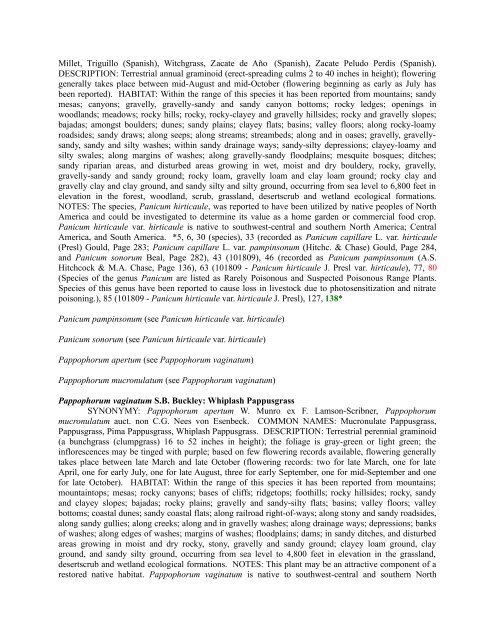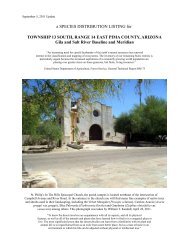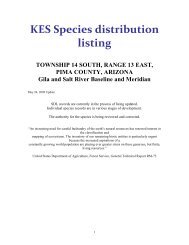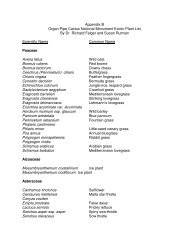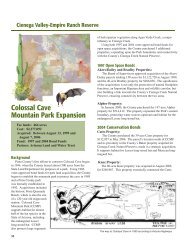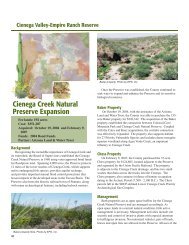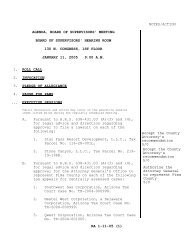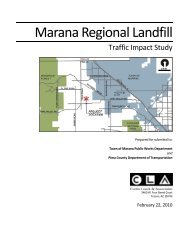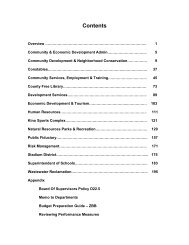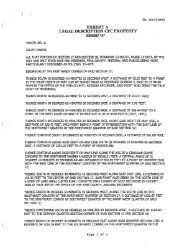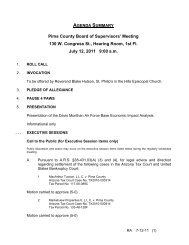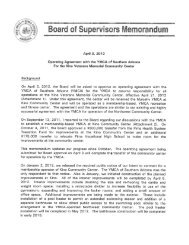Le Jardin de Mère Nature dans une Petite Planète - Pima County
Le Jardin de Mère Nature dans une Petite Planète - Pima County
Le Jardin de Mère Nature dans une Petite Planète - Pima County
Create successful ePaper yourself
Turn your PDF publications into a flip-book with our unique Google optimized e-Paper software.
Millet, Triguillo (Spanish), Witchgrass, Zacate <strong>de</strong> Año (Spanish), Zacate Peludo Perdis (Spanish).<br />
DESCRIPTION: Terrestrial annual graminoid (erect-spreading culms 2 to 40 inches in height); flowering<br />
generally takes place between mid-August and mid-October (flowering beginning as early as July has<br />
been reported). HABITAT: Within the range of this species it has been reported from mountains; sandy<br />
mesas; canyons; gravelly, gravelly-sandy and sandy canyon bottoms; rocky ledges; openings in<br />
woodlands; meadows; rocky hills; rocky, rocky-clayey and gravelly hillsi<strong>de</strong>s; rocky and gravelly slopes;<br />
bajadas; amongst boul<strong>de</strong>rs; d<strong>une</strong>s; sandy plains; clayey flats; basins; valley floors; along rocky-loamy<br />
roadsi<strong>de</strong>s; sandy draws; along seeps; along streams; streambeds; along and in oases; gravelly, gravellysandy,<br />
sandy and silty washes; within sandy drainage ways; sandy-silty <strong>de</strong>pressions; clayey-loamy and<br />
silty swales; along margins of washes; along gravelly-sandy floodplains; mesquite bosques; ditches;<br />
sandy riparian areas, and disturbed areas growing in wet, moist and dry boul<strong>de</strong>ry, rocky, gravelly,<br />
gravelly-sandy and sandy ground; rocky loam, gravelly loam and clay loam ground; rocky clay and<br />
gravelly clay and clay ground, and sandy silty and silty ground, occurring from sea level to 6,800 feet in<br />
elevation in the forest, woodland, scrub, grassland, <strong>de</strong>sertscrub and wetland ecological formations.<br />
NOTES: The species, Panicum hirticaule, was reported to have been utilized by native peoples of North<br />
America and could be investigated to <strong>de</strong>termine its value as a home gar<strong>de</strong>n or commercial food crop.<br />
Panicum hirticaule var. hirticaule is native to southwest-central and southern North America; Central<br />
America, and South America. *5, 6, 30 (species), 33 (recor<strong>de</strong>d as Panicum capillare L. var. hirticaule<br />
(Presl) Gould, Page 283; Panicum capillare L. var. pampinsonum (Hitchc. & Chase) Gould, Page 284,<br />
and Panicum sonorum Beal, Page 282), 43 (101809), 46 (recor<strong>de</strong>d as Panicum pampinsonum (A.S.<br />
Hitchcock & M.A. Chase, Page 136), 63 (101809 - Panicum hirticaule J. Presl var. hirticaule), 77, 80<br />
(Species of the genus Panicum are listed as Rarely Poisonous and Suspected Poisonous Range Plants.<br />
Species of this genus have been reported to cause loss in livestock due to photosensitization and nitrate<br />
poisoning.), 85 (101809 - Panicum hirticaule var. hirticaule J. Presl), 127, 138*<br />
Panicum pampinsonum (see Panicum hirticaule var. hirticaule)<br />
Panicum sonorum (see Panicum hirticaule var. hirticaule)<br />
Pappophorum apertum (see Pappophorum vaginatum)<br />
Pappophorum mucronulatum (see Pappophorum vaginatum)<br />
Pappophorum vaginatum S.B. Buckley: Whiplash Pappusgrass<br />
SYNONYMY: Pappophorum apertum W. Munro ex F. Lamson-Scribner, Pappophorum<br />
mucronulatum auct. non C.G. Nees von Esenbeck. COMMON NAMES: Mucronulate Pappusgrass,<br />
Pappusgrass, <strong>Pima</strong> Pappusgrass, Whiplash Pappusgrass. DESCRIPTION: Terrestrial perennial graminoid<br />
(a bunchgrass (clumpgrass) 16 to 52 inches in height); the foliage is gray-green or light green; the<br />
inflorescences may be tinged with purple; based on few flowering records available, flowering generally<br />
takes place between late March and late October (flowering records: two for late March, one for late<br />
April, one for early July, one for late August, three for early September, one for mid-September and one<br />
for late October). HABITAT: Within the range of this species it has been reported from mountains;<br />
mountaintops; mesas; rocky canyons; bases of cliffs; ridgetops; foothills; rocky hillsi<strong>de</strong>s; rocky, sandy<br />
and clayey slopes; bajadas; rocky plains; gravelly and sandy-silty flats; basins; valley floors; valley<br />
bottoms; coastal d<strong>une</strong>s; sandy coastal flats; along railroad right-of-ways; along stony and sandy roadsi<strong>de</strong>s,<br />
along sandy gullies; along creeks; along and in gravelly washes; along drainage ways; <strong>de</strong>pressions; banks<br />
of washes; along edges of washes; margins of washes; floodplains; dams; in sandy ditches, and disturbed<br />
areas growing in moist and dry rocky, stony, gravelly and sandy ground; clayey loam ground, clay<br />
ground, and sandy silty ground, occurring from sea level to 4,800 feet in elevation in the grassland,<br />
<strong>de</strong>sertscrub and wetland ecological formations. NOTES: This plant may be an attractive component of a<br />
restored native habitat. Pappophorum vaginatum is native to southwest-central and southern North


